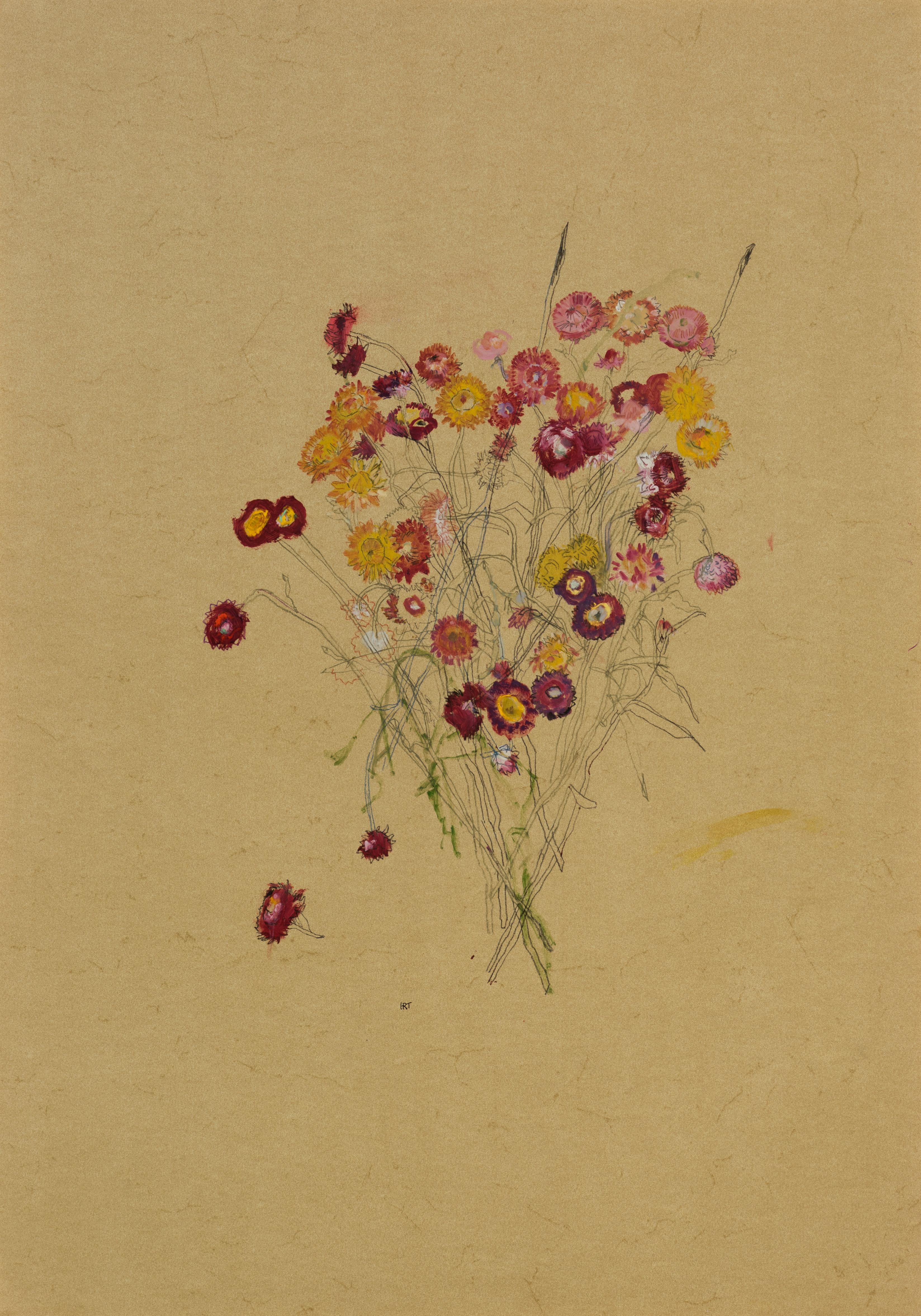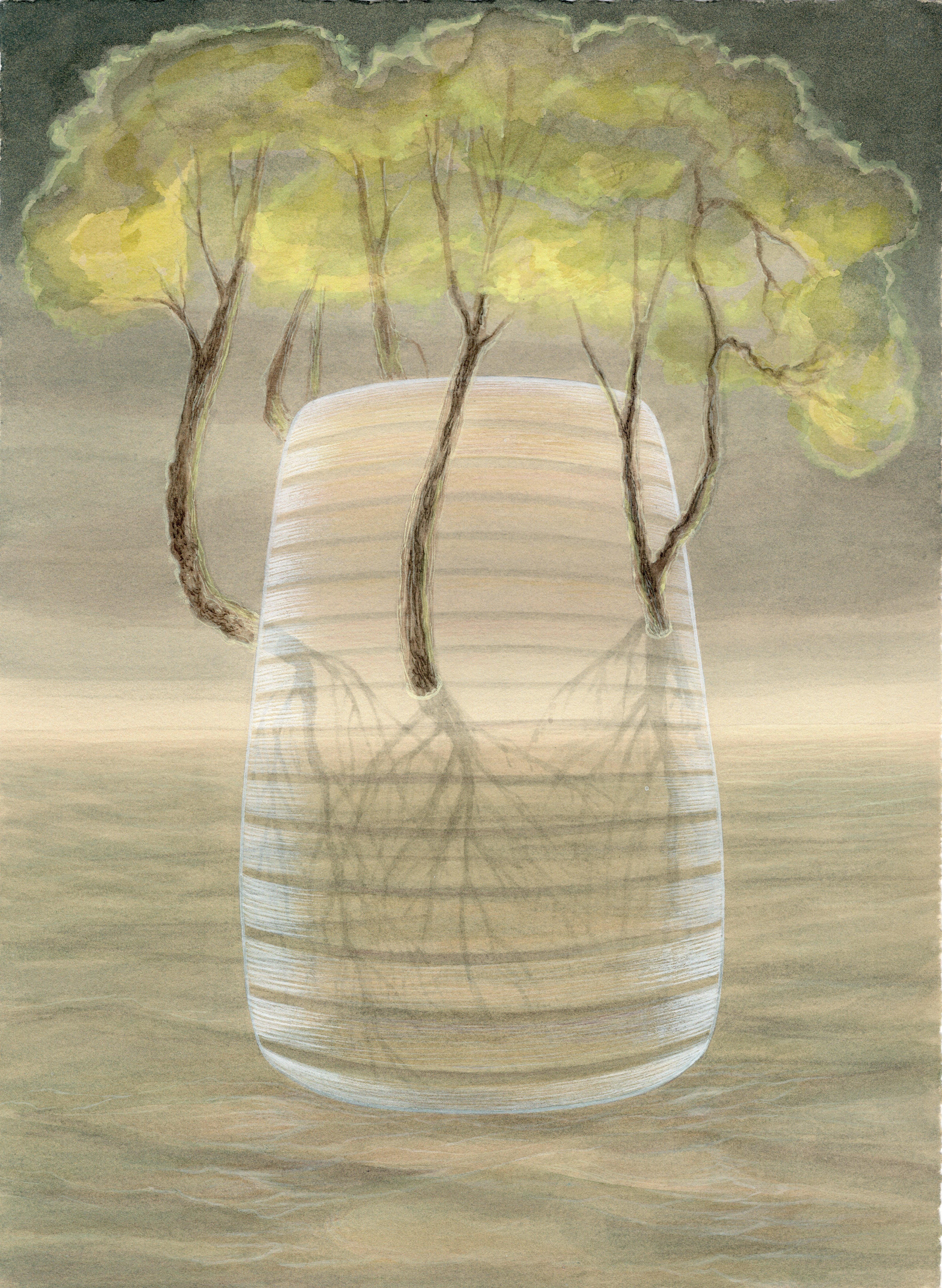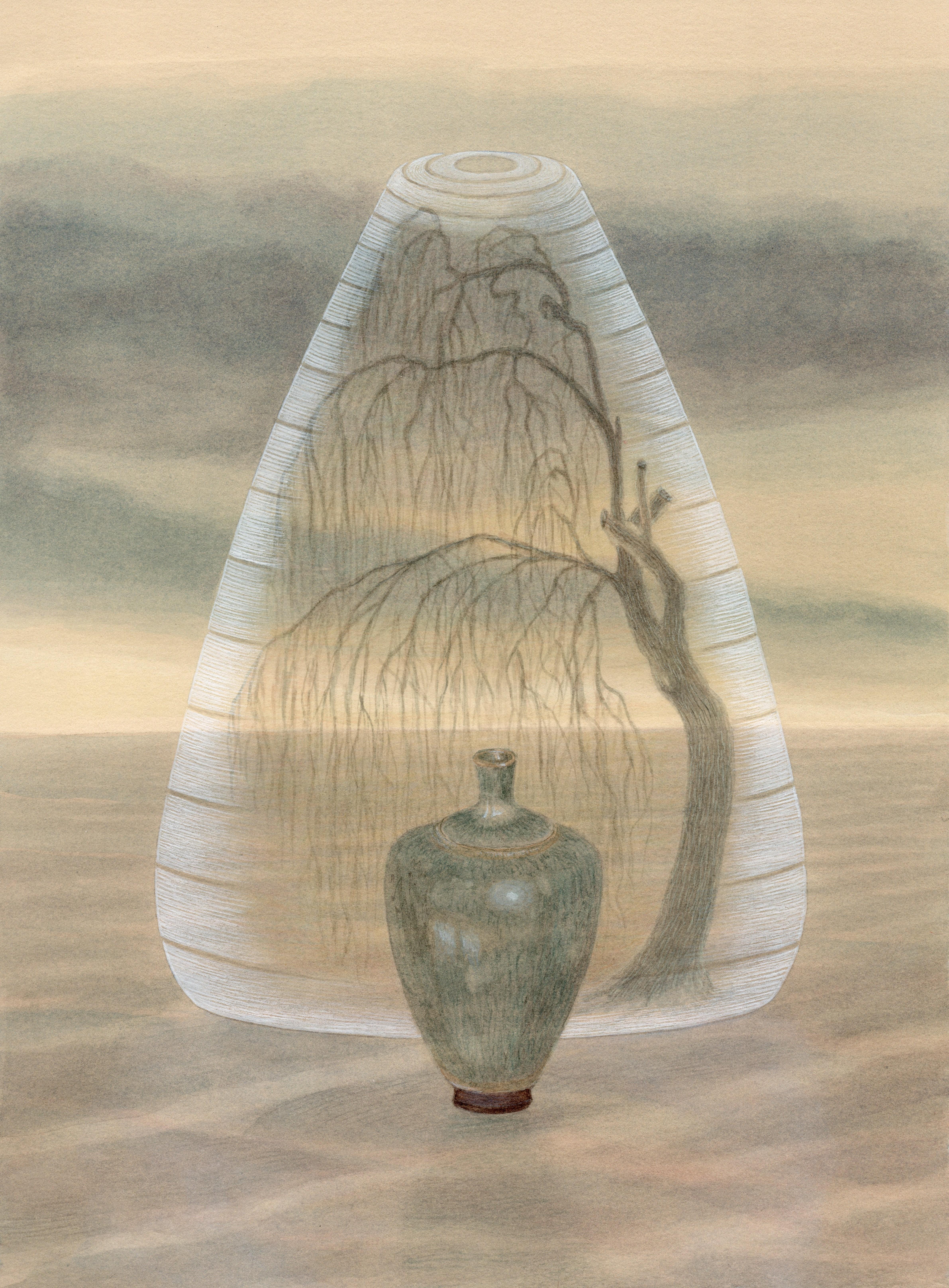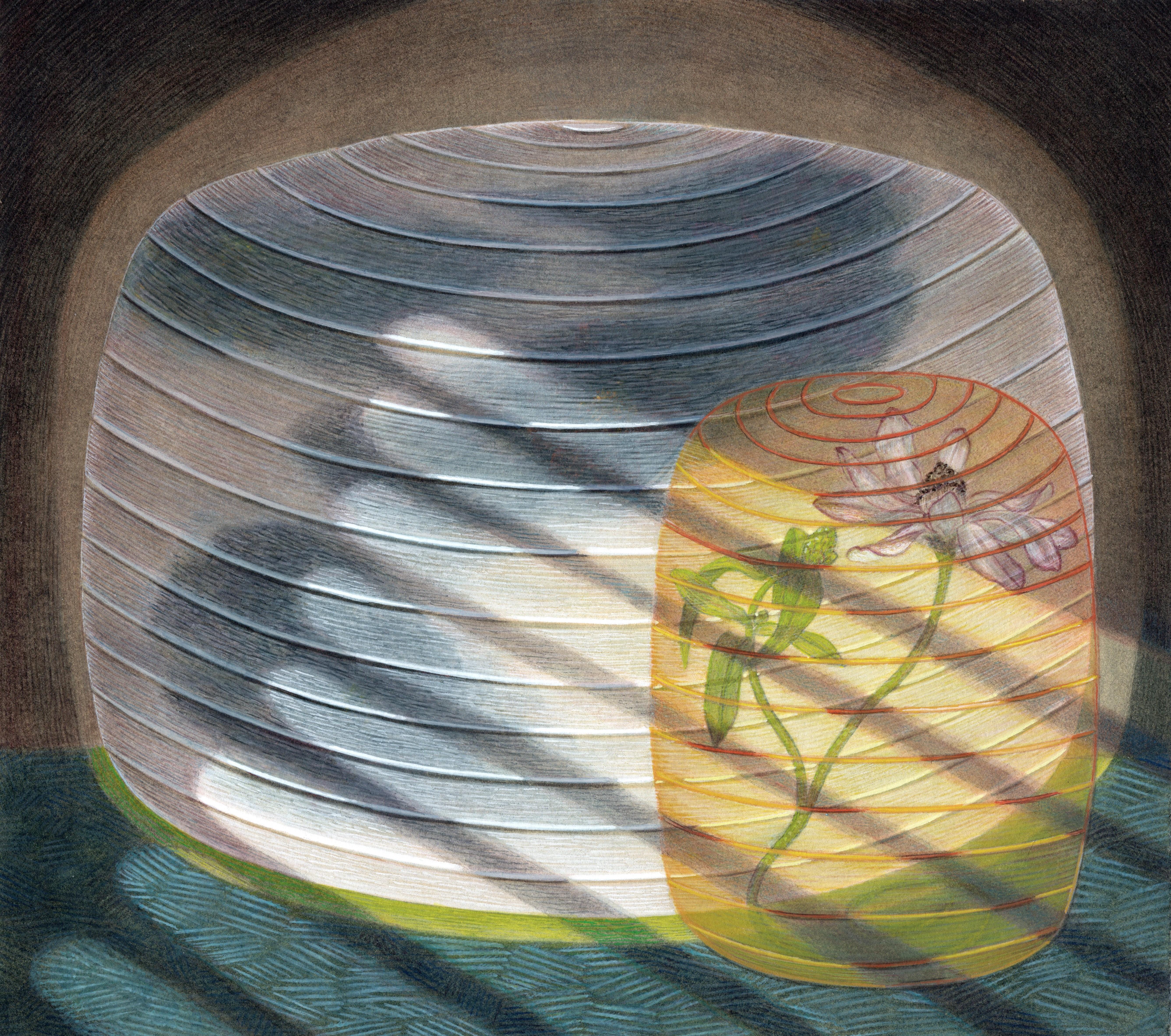Items Similar to untitled (Reclining Female Nude)
Want more images or videos?
Request additional images or videos from the seller
1 of 11
Charles Harris ( Beni Kosh )untitled (Reclining Female Nude)1950
1950
About the Item
Aka Beni Kosh
Still Life with Flowers
Colored pencil on paper
Unsigned
Signed with the estate stamp on reverse (see photo)
Estate No. 716
Condition: Soft fold through image, wrinkles to sheet
Sheet size: 19 x 25 inches
Provenance: Estate of the Artist
“An African-American born Charles E. Harris, the name under which he painted until the early 1960s when he took the name of Kosh. His paintings span the period 1949-71, and reflect abstract and surreal figurative subjects which include Cleveland street scenes, jazz clubs, and depictions of Christ.”
Courtesy of Rachel Davis Fine Art
“Beni E. Kosh was born as Charles Elmer Harris, in Cleveland Ohio. He changed his name in the 1960’s, which translates to “Son of Ethiopia”. He rarely exhibited or sold his work and was affiliated with the African-American artists’ “Sho-nuff Art Group” and the Karamu House and studied under Cleveland artist Paul Travis. His style is very diverse and he experimented with Cubism, portraiture and abstractions in series. His paintings span from 1949 – 1971, and reflect abstract and surreal figurative subjects, which include Cleveland street scenes, jazz clubs, and depictions of Christ. He received little recognition during his lifetime and was only “rediscovered” literally days after his death when hundreds of his paintings were rescued by an art dealer.”
(Courtesy Pennsylvania Art Conservatory
“The outsider artist Beni Kosh, largely self-trained, born as Charles Harris in Cleveland in 1917, who was heavily influenced by Cubism and Surrealism. In honor of his friendship with the late Armond Cohen, former rabbi at Park Synagogue, Harris late in life adopted a Hebrew name that can be translated as "my son is black" or "son of
Ethiopia."
Courtesy Clevelandcom
- Creator:Charles Harris ( Beni Kosh ) (1917 - 1993, American)
- Creation Year:1950
- Dimensions:Height: 19 in (48.26 cm)Width: 25 in (63.5 cm)
- Medium:
- Movement & Style:
- Period:
- Condition:
- Gallery Location:Fairlawn, OH
- Reference Number:
About the Seller
5.0
Recognized Seller
These prestigious sellers are industry leaders and represent the highest echelon for item quality and design.
Platinum Seller
These expertly vetted sellers are 1stDibs' most experienced sellers and are rated highest by our customers.
Established in 1978
1stDibs seller since 2013
711 sales on 1stDibs
Typical response time: 1 hour
Associations
International Fine Print Dealers Association
- ShippingRetrieving quote...Ships From: Fairlawn, OH
- Return PolicyA return for this item may be initiated within 10 days of delivery.
More From This SellerView All
- Baggage Claim, Bags #2By Darius StewardLocated in Fairlawn, OHSigned "Rhonda V" in memory of the artist's mother From the series: Baggage Claim, inspired by the death of the artist's mother. The reference to "Baggage" is symbolic to all the emotion and hurt one accumulates through life and how the accumulations weights down on the spirit. Watercolor on Yupo paper...Category
2010s Contemporary Still-life Drawings and Watercolors
MaterialsWatercolor
- Baggage Claim (Bags #1)By Darius StewardLocated in Fairlawn, OHCreated in 2017 this series, Baggage Claim, speaks to the symbolic emotional weight one accumulates through life and how the accumulations weigh down the spirit. The artist used handbags...Category
2010s Contemporary Still-life Drawings and Watercolors
MaterialsWatercolor
- Plum Branches and FlowersBy Joseph O'SickeyLocated in Fairlawn, OHPlum Branches and Flowers watercolor on wove paper, 1985 Signed and dated in pencil lower right corner From the artist's 1985 sketchbook Inspired by O'Sickey's love of Japanese and Chinese art and calligraphy. Provenance: Estate of the artist Condition: Excellent Image/Sheet size: 13 5/8 x 17 inches Joseph B. O’Sickey, Painter 1974 CLEVELAND ARTS PRIZE FOR VISUAL ARTS The title conferred on him by Plain Dealer art critic Steve Litt in a 1994 article, “the dean of painting in northeast Ohio,” must have pleased Joseph O'Sickey. It was more than 30 years since he had burst onto the local (and national) art scene. O’Sickey was already in his 40s in that spring of 1962 when he had his first one-man show at the Akron Art Museum and was signed by New York’s prestigious Seligmann Galleries, founded in 1888. In the decade and a half that followed, he would have seven one-man shows at Seligmann, which had showed the work of such trailblazing figures as Seurat, Vuilliard, Bonnard, Leger and Picasso, and appear in all of the group shows. O’Sickey took the Best Painting award in the 1962 May Show at the Cleveland Museum of Art (CMA). He and would capture the same honor in back-to-back May Shows in 1964 and ’65, and again in 1967. The remarkable thing, noted the Plain Dealer’s Helen Borsick, was that he accomplished this sweep in a variety of painterly styles, even using that most hackneyed of subjects, flowers. “The subject doesn’t matter,” he told her, “what the artist brings to it is the important thing.” O’Sickey’s garden and landscape paintings were big and bold, eschewing delicate detail in favor of vitality and impact. The great art collector and CMA benefactor Katherine C. White, standing before one of O’Sickey’s vivid garden paintings, compared the sensation to “being pelted with flowers.” Though he might represent an entire blossom with one or two smudged brush strokes or a stem with a simple sweep of green, O’Sickey rejected the moniker of Impressionist—or Pointillist or Abstract painter or Expressionist. “My work,” he said, “is a direct response to the subject. I believe in fervor and poetic metaphor. I try to make each color and shape visible and identifiable within the context of surrounding colors and shapes. A yellow must hold its unique quality from any another yellow or surrounding color, and yet read as a lemon or an object, by inference. It does not require shading or modeling—the poetic evocation is part of the whole.” “The subject,” O’Sickey used to tell his students at Kent State University, where he taught painting from 1964 to 1989, “has to be seen as a whole and the painting has to be structured to be seen as a whole.” He liked to think of it as “a process of controlled rapture.” When, in the 1960s, fond childhood memories drew him to the zoo, he found himself responding to the caged animals in their lonely dignity (or indignity) with sharp-edged, almost silhouette-like forms that evoked Matisse’s paintings and cut-paper assemblages. One observer was left with the impression that the artist had “looked at these animals, past daylight and into dusk when they lose their details in shadow and become pure shapes, with eyes that are seeing the viewer rather than the other way around. This is a world of shape and essence,” wrote Helen Borsick. “All is simplification.” O’Sickey attributed his ability to capture his subjects with just a few strokes—in an almost iconographic way—to a rigorous exercise he had imposed upon himself over a period of several months. Limiting his tools to a large No. 6 bristle brush and black ink, he set himself the task of drawing his pet parakeet and the other small objects in its cage (cuttlebone, feeding dish, tinkling bell) hundreds of times. The exercise gave him “invaluable insights into painting. . . . Because of the crudity of the medium, every part of these drawings had to be an invention and every mark had to have its room and clarity.” Then he began adding one color at a time—“still with the same brush and striving for the same clarity”—and headed off to the zoo where “the world opened up to me. I learned how little it took to express the subject.” Born in Detroit at the close of the First World War, O’Sickey grew up in St. Stanislaus parish near East 65th and Fleet on Cleveland’s southeast side. (The apostrophe was inserted into the family’s proud Polish name by a clerk at Ellis Island.) An early interest in drawing and painting may have been kindled by the presence on the walls of Charles Dickens Elementary School, one of only three grade schools in the district with a special focus on the arts, of masterful watercolors by such Cleveland masters as Paul Travis, Frank N. Wilcox and Bill Coombes. As a youngster O’Sickey took drawing classes at the Cleveland Museum of Art, and he and his brother spent hours copying famous paintings; while a student at East Tech High School in the mid-’30s, he attended free evening classes in life drawing with Travis and Ralph Stoll at the John Huntington Art and Polytechnic Institute, and Saturday classes at the Cleveland School (later the Cleveland Institute) of Art, where he earned his degree in 1940 under the tutelage of Travis, Stoll and such other legendary figures as Henry Keller, Carl Gaertner, William Eastman, Kenneth Bates...Category
1980s Contemporary Still-life Drawings and Watercolors
MaterialsWatercolor
- Homage to MorandiBy Phyllis SloaneLocated in Fairlawn, OHHomage to Morandi Watercolor, c. 1990 Signed lower right: Sloane An important exhibition size watercolor by the artist. Acquired by the Cleveland Clinic, de-accessed in 2021 Conditio...Category
1990s Contemporary Still-life Drawings and Watercolors
MaterialsWatercolor
- untitled (Shell #773: Interior)Located in Fairlawn, OHUnknown Artist, Japanese, 20th century Unsigned Inscription in Japanese that repeats the EnglishCategory
20th Century Drawings and Watercolor Paintings
MaterialsWatercolor
- Chrysanthemums and Tiger LiliesBy Clarence Holbrook CarterLocated in Fairlawn, OHChrysanthemums and Tiger Lilies Signed and dated lower left (twice), see photo Watercolor on paper, 1935 A symbol of the sun, the Japanese consider the or...Category
1930s Realist Drawings and Watercolor Paintings
MaterialsWatercolor
You May Also Like
- Poppies & Tulips, Mixed media on Pergamenata parchmentBy Howard TangyeLocated in London, GBHoward Tangye (b.1948, Australia) has been an influential force in fashion for decades. Lecturing at London’s Central Saint Martins for 35 years, including 16 years as head of BA Wom...Category
2010s Contemporary Still-life Drawings and Watercolors
MaterialsPaint, Paper, Parchment Paper, Charcoal, Crayon, Oil Crayon, Oil Pastel,...
- Flowers (Helichrysum), Mixed media on ochre parchmentBy Howard TangyeLocated in London, GBHoward Tangye (b.1948, Australia) has been an influential force in fashion for decades. Lecturing at London’s Central Saint Martins for 35 years, including 16 years as head of BA Wom...Category
2010s Contemporary Still-life Paintings
MaterialsPaint, Paper, Chalk, Charcoal, Crayon, Oil Crayon, Oil Pastel, Pastel, W...
- R.I.P. KobeBy Ruby SilviousLocated in Philadelphia, PAThis purple, white, beige and orange painting titled "R.I.P. Kobe" is an original artwork by Ruby Silvious made of watercolor and gouache on used tea bag. This...Category
21st Century and Contemporary Contemporary Still-life Paintings
MaterialsFound Objects, Watercolor, Gouache, Tea
- Willow - Botanical Watercolor & Gouache on Paper with Single Bud Vase and TreeBy Christina HaglidLocated in Chicago, ILA single bud vase, a willow tree seeming to grow inside a confined vessel, all appearing to float upon a sea of moving water are the subjects of Christ...Category
21st Century and Contemporary Contemporary Landscape Drawings and Waterc...
MaterialsWatercolor, Gouache, Archival Paper
- Canopy, Trees Emerging from a Vase, Botanical Watercolor & Gouache on PaperBy Christina HaglidLocated in Chicago, ILTree roots emerge from a vase to create a forest of trees in Christina Haglid's "Canopy". The artist invites the viewer to take a closer look at nature, to question what is seen and to enter into a newly created world. Meticulous in her execution, Haglid uses watercolor as one might use a colored pencil. Layer upon layer of color is added to achieve this impressively detailed painting. Christina Haglid Canopy watercolor and gouache on paper 11h x 8w in 27.94h x 20.32w cm CMH033 Artist's Statement Tiny Sanctuaries There has always been an intersection between the process of writing and the act of painting in my work. It has somehow been my guide. In the last four years, during the making of this work, that connection intensified as I started writing short stories and flash fiction while taking online classes. I find the process of writing and painting so different in almost every way, but there is something freeing and generative in writing which helps my painting process. Or perhaps it's a reminder of what painting is for me - something intuitive that needs to be trusted. And what they do have in common is a desire to encapsulate and distill a single moment, a story, about the complexity of our emotions and experiences. At the heart of my work is the recurring depiction of perseverance, strength of will, and a subtle optimism. Symbolically through the objects, precarious situations depict a moment of possible difficulty, often involving the influence of nature. A paper crane left in the snow. A boat nearly filled to the brim, but not submerged and able to drain its own contents carefully. A slide alone at...Category
21st Century and Contemporary Contemporary Landscape Drawings and Waterc...
MaterialsWatercolor, Gouache, Archival Paper
- Double Blind, Still Life with Sun Kissed Paper Lanterns & Blooming FlowerBy Christina HaglidLocated in Chicago, ILA single bloom is captured inside a paper lantern atop a table in Christina Haglid's "Double Blind". This small, exquisite watercolor is awash in sunlight streaming in through parti...Category
21st Century and Contemporary Contemporary Landscape Drawings and Waterc...
MaterialsWatercolor, Gouache, Archival Paper





